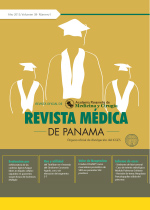Meningitis por Cryptococcus neoformans: Experiencia clínica y consideraciones terapéuticas en el Hospital Santo Tomás desde el 1 de enero de 2007 al 31 de diciembre de 2011.
Autores/as
DOI:
https://doi.org/10.37980/im.journal.rmdp.2013137Resumen
Resumen: Meningitispor Cryptococcus neoformans enpacientes con SIDA: experiencia clínica en el Hospital Santo Tomás. Palabras clave: meningitis criptococócica, SIDA, anfotericina B. Introducción: Lameningitis criptococósica es la cuarta infección oportunista en personas conSIDA y en países en desarrollo sigue siendo una importante causa de muerte,debido a que la TARGA no es universalmente disponible. Metodología: Serealizó un estudio descriptivo retrospectivo, de pacientes infectados con VIH,con diagnóstico de meningitis por Cryptococcusadmitidos al HST durante un período de cinco años (1 de enero 2007- 31 dediciembre 2011)Resultados: Losdatos de 28 pacientes (17 hombres, 11 mujeres) fueron recopilados y analizados.La media de edad estuvo en los 31.6 años. El 35% estuvo algún contacto con TARpreviamente. La presentación clínica predominante incluyó cefalea (96.4%) yvómitos (82.1%); sólo 42.9% presentaron fiebre. Las principales alteracionesdel líquido cefalorraquídeo fueron hipoglucorraquia (96.4%), tinta indiapositiva (92.8%), incremento en la presión de apertura (57.1%). Sólo 8/28pacientes tenían realizada cuenta de CD4+ de los cuales 5 eran menores de 100células/mm3. Todos los pacientes recibieron anfotericina B comomonoterapia debido a que la flucitosina no está disponible. La media deestancia hospitalaria fue de 22.6 días. La mortalidad intrahospitalaria fue de50%.Conclusiones: Lameningitis criptococócica sigue siendo unaimportante causa de morbilidad y mortalidad en la población panameña con SIDA,a pesar que la TARGA está disponible. Hay que implementar estrategias paraprevenir estas infecciones oportunistas.
Abstract
Background: Cryptococcal meningitis is the fourth most common cause of opportunistic infections in people living with HIV/AIDS and in developing countries persist to be an important cause of death, since HAART is not universally available. Methods: Descriptive retrospective study was made for patients with Cryptococcal meningitis with AIDS admitted at Hospital Santo Tomás (Panama, Panama) during a five year period (Jan 2007 -Dec 2011). Results: Data for 28 patients (17 male, 11 female) were analyzed. The mean age was 31.6 years and 36% of the patients were already in Highly Active Antiretroviral Therapy (HAART) at the moment of cryptococcal meningitis diagnosis, most of them with at least two month of therapy. The predominant clinical presentation included headache (96.4%)and vomiting (82.1%) and only a 42.9% presented with fever. Decreased glucose (96.4%) and a positive india ink (92.8%) were the main alterations of cerebrospinal fluid and half of them (57.1%) presented with an increased lumbar puncture opening pressure. Only 8 out of 28 had a CD4+ count realized with all of them with less than 200 cells/mm3 and five with less tan 100 cells/mm3. All patients received amphotericin B as monotherapy since flucytosine is not available and the mean hospital stay was 22.6 days. The in-hospital mortality was of 50% and recurrence was observed in five patients, considering that only nine patients continued ambulatory follow-up receiving Amphoterin B biweekly or weekly since oral fluconazol is not always affordable for patients. Conclusions: Cryptococcal meningitis persists to be an important cause of morbidity and mortality in the panamenian population living with AIDS even with HAART being available. The implementation of new strategies to prevent this opportunistic infection should be developed.
Key words: cryptococcal meningitis, AIDS, Amphotericin B.
Publicado
Número
Sección
Licencia
Derechos autoriales y de reproducibilidad. La Revista Médica de Panama es un ente académico, sin fines de lucro, que forma parte de la Academia Panameña de Medicina y Cirugía. Sus publicaciones son de tipo acceso gratuito de su contenido para uso individual y académico, sin restricción. Los derechos autoriales de cada artículo son retenidos por sus autores. Al Publicar en la Revista, el autor otorga Licencia permanente, exclusiva, e irrevocable a la Sociedad para la edición del manuscrito, y otorga a la empresa editorial, Infomedic International Licencia de uso de distribución, indexación y comercial exclusiva, permanente e irrevocable de su contenido y para la generación de productos y servicios derivados del mismo. En caso que el autor obtenga la licencia CC BY, el artículo y sus derivados son de libre acceso y distribución.






